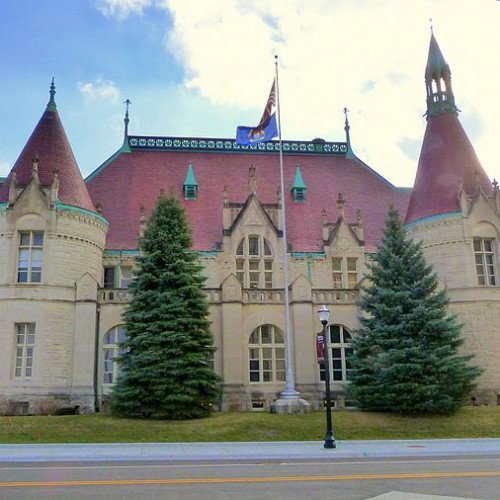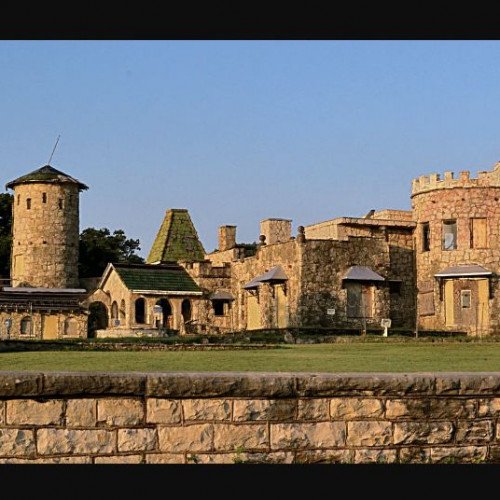Castles of "United States" CASTLE MUSEUM vs CASTLE OF HERON BAY

CASTLE MUSEUM
The Castle Museum, previously known as Castle Station or Saginaw Post Office, in Saginaw, Michigan, United States is a historic structure on the National Register of Historic Places. It is currently the home of the Historical Society of Saginaw County and officially known as the Castle Museum of Saginaw County History. The Castle Museum was designed by William Martin Aiken, the Supervising Architect of the US Treasury, and built in 1898 as a United States Post Office under a federal building program to reflect the ethnic and cultural heritage of its community. Aiken used the influence of the European chateau to illustrate the Saginaw Valley's earliest white settlers-French fur traders and trappers, and combine it with decorations from the Italian Renaissance and Gothic periods. The Castle Building was on the verge of extinction in the 1930s. Unable to keep up with Saginaw's growing mail business, the Castle Post Office Station was too small and plans were made to replace it. A decision was made to tear it down and build a new post office on its site. A storm of protests and a petition signed by 1,000 residents was sent to Washington. The signers of the petition called the building “one of the best and most attractive buildings in Michigan” the replacement order was canceled in 1933. A final decision to demolish was made in February 1935 more protests followed and a compromise was made on February 17, 1935 the building would be extensively remodeled. The building was remodeled by local architect Carl Macomber, who enlarged the building by adding wings on both ends using limestone from the same quarry as the original building, tore down one of the three turrets, and added a large sorting room on the back of the building by Hoyt Library. Construction was completed in 1937 and Postmaster General James A. Farley labeled the building “memorial to President Roosevelt”. In the 1970s, a new post office was built and the building was almost demolished once again, but local citizens and the Saginaw County Board of Commissioners took steps to list the building on the National Register of Historic Places to ensure the preservation of the building and the local heritage it represents.
Statistics for this Xoptio

CASTLE OF HERON BAY
This place is on private property. Listing for informational purposes only. Please do not visit without express permission from the land owner. This extraordinary stone mansion, sited on a rise above the south shore of Lake Worth was begun by the Whiting in the late 1920's and was largely completed by 1938. Reportedly, Whiting won the property from a Mr. McPherson in a poker game. The round crenellated front wing and rear tower give the rambling structure the appearance of a castle. Mr. and Mrs. Samuel E. Whiting, wealthy Fort Worth residents called it "Inverness." Mrs. Whiting designed and personally supervised the construction of the house. A one story gabled rear wing is believed to be a three-room stone farm house that reputedly was build on this site around 1860. It is difficult to trace early ownership of the property because the 1876 courthouse fire destroyed the deed records, but Ulrick Cannon reputedly owned the property during the Civil War and Julian Feild acquired it after the war ended. It is not known who built the stone house, but records do indicate that the land was homesteaded by D.P. Terrell as early as 1872 - the first indicationthat a residence stood on the property. The Charles Turner family owned the property between 1873 and 1894, and the Oliver S. Kennedy family held it between 1904 and 1911, when it was sold to the City of Fort Worth because portions of land were needed for the Lake Worth project. After construction of Lake Worth, the City of Fort Worth leased the lake front property, and many homes were built around the shore of Lake Worth. It is during this period that the Whitings constructed what has come to be known locally as the "Lake Worth Castle" and the guest cottages across Heron Drive to the West. During the ownership by the Whiting's it is believed that their son committed suicide at the castle and it also suffered a serious fire in 1939. The Vultee Aircraft Corporation leased the estate between 1944 and 1954, probably using it to entertain visiting businessmen and dignitaries. Jimmy Stewart stayed here in the early 1950's during the filming of "Strategic Air Command" at nearby Carsell Air Force Base. General Dwight D. Eisenhower spend time here also.In the mid 70's,Tony and Marian May offered Adult Self-Improvement Training Programs at the Castle and called it "Castle St. Michael." The mid 80's found the castle owned by a John Pigenburg from Hawaii and a Richard Ruiz who left the property as you see it today.